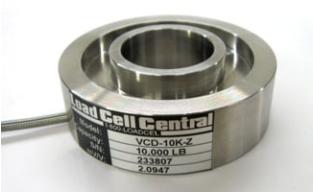The Complete Buyer’s Guide to Choosing the Right Load Cell for Your Application
July 2, 2025

Load cells are precision sensors that convert force or weight into an electrical signal, forming the foundation of accurate measurement systems across industries such as manufacturing, research, and logistics. From automating production lines to improving quality control and ensuring safe transport of goods, load cells deliver the reliable data modern operations depend on.
Selecting the right load cell can be complex. With numerous configurations, materials, and specifications available, it’s important to understand the unique demands of your application before making a decision. This guide simplifies that process, helping you identify the ideal load cell type and configuration for your environment.
Understanding Load Cells and Their Types
A load cell is a precision transducer that converts mechanical force—tension, compression, or pressure—into an electrical output signal. Most load cells use bonded strain gauges that slightly deform when subjected to force, changing their electrical resistance. That change is then converted into a proportional electrical signal, allowing force or weight to be measured with high accuracy.
Different load cell types are designed to handle specific measurement conditions:
- Compression Load Cells: Measure downward or compressive forces. Commonly used in weighbridges, truck scales, and heavy platform applications.
- Tension Load Cells: Measure pulling forces, making them ideal for crane scales, suspended systems, and tensile testing.
- Shear Beam Load Cells: Designed to measure bending or shear forces, often used in floor scales, conveyor systems, and tank weighing.
- S-Type Load Cells: Recognized by their “S” shape, these handle both tension and compression, offering versatility for hopper weighing, material testing, and industrial monitoring.
Key Factors to Consider When Choosing a Load Cell
When selecting a load cell, several key parameters will influence performance and longevity. The goal is to balance precision, durability, and cost based on your application’s requirements.
1. Capacity and Range
A load cell’s capacity defines the maximum force it can measure safely. Choosing the right capacity is crucial:
- If the rating is too high, small loads may not register accurately.
- If it’s too low, overload or permanent damage can occur.
A good rule of thumb is to select a load cell rated about 20–30% above your maximum expected load, providing a safety margin without sacrificing sensitivity.
2. Accuracy and Resolution
Accuracy reflects how closely the output matches the actual load, while resolution indicates the smallest change the sensor can detect.
- High accuracy and fine resolution are essential for laboratory and research environments.
- Industrial applications may accept slightly lower accuracy in exchange for ruggedness or higher load capacity.
Check the manufacturer’s accuracy classification—often expressed as a percentage of full-scale output—to ensure it meets your process requirements.
3. Environmental Conditions
Temperature fluctuations, vibration, moisture, and chemical exposure can all affect a load cell’s performance.
- For wet or corrosive environments, choose stainless steel construction and a high IP (Ingress Protection)
- In extreme temperatures, look for temperature-compensated models to minimize signal drift.
- If vibration is unavoidable, select load cells with mechanical damping or integrated overload protection.
Proper environmental matching extends equipment life and maintains measurement stability.
How to Select the Right Load Cell for Your Application
The best load cell is the one that fits your specific process, environment, and performance goals. Follow these steps to narrow down your options:
- Define Your Application Requirements
Identify the type of force (tension, compression, or both) and determine the maximum expected load. - Select the Correct Capacity
Choose a capacity slightly above your maximum load for accuracy and safety. - Choose the Appropriate Type
Match the load direction and mounting setup to the correct sensor type—compression, tension, shear beam, or S-type. - Determine Required Accuracy
High-precision tasks (e.g., R&D, testing) require load cells with tight tolerances. For general industrial use, mid-range accuracy typically suffices. - Assess Environmental Factors
Consider exposure to temperature, moisture, vibration, or dust. Select materials and sealing that can withstand those conditions. - Review Mounting and Compatibility
Confirm the load cell’s mechanical interface fits your existing equipment. Misalignment or poor installation can reduce accuracy and lifespan. - Consider Special Requirements
For non-standard environments—such as high-temperature, underwater, or high-shock applications—custom load cells or specialized accessories may be necessary.
Selecting the correct load cell ensures not only accurate measurement but also improved reliability and reduced maintenance over time.
For assistance in identifying the best sensor for your setup, contact Load Cell Central. Our experienced engineers can recommend the ideal solution based on your operating conditions and performance goals.